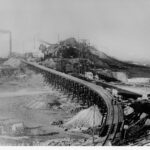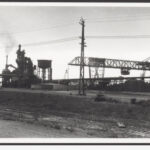The syndicate which began mining high-grade silver–lead–zinc ore in 1883, following a discovery of what was thought to be tin in the Barrier Range of New South Wales, became the Broken Hill Proprietary Co. Ltd (BHP) in August 1885 when the company was floated on the stock exchange in Melbourne, its headquarters to the present. Subsequently the town of Broken Hill, 50km east of the South Australian border, and the mining activity that grew up around it have been closely linked to South Australia.
Smelting operations, which began at Port Pirie in the Mid North in 1889, as the nearest suitable seaport to Broken Hill, were taken over by BHP in 1892. With other mining companies, BHP formed Broken Hill Associated Smelters when the export of lead concentrates to Europe was interrupted during the First World War; BHP sold its shareholding in 1925.
BHP in Whyalla
Essington Lewis promoted BHP’s activities in South Australia, but only if BHP would benefit. With the help of the South Australian government, he persuaded the company to build a blast furnace at Whyalla, on the Eyre Peninsula. BHP received various concessions, and the government agreed to build a water pipeline 355km from Morgan in the Murray Region to Whyalla, thereby extending a reliable water supply into the northern agricultural region. The outbreak of the Second World War highlighted the need to decentralise industries such as shipbuilding. In January 1940 BHP agreed to establish a shipyard at Whyalla: the keels for two Royal Australian Navy patrol boats were laid even before the blast furnace was completed.
Lessened influence of South Australia on BHP
The state’s influence on BHP’s board lessened considerably from the mid 1950s. Despite exploratory work and expansion of iron ore mining in the Middleback Range west of Whyalla, not until 1958 did the government and BHP reach agreement on the construction of a steelworks at Whyalla. In October 2000 BHP Steel’s Long-Products Division, including the Whyalla steelworks and its Middleback Range iron ore source, was floated as an independent company, OneSteel, and in 2001 BHP merged with an Anglo-Dutch company to form BHP Billiton. In 2012 the company shelved plans to expand its massive copper–uranium–gold–silver–lead mine at Olympic Dam, but continued to investigate the option. Meanwhile the company operates a diverse range of mining and processing operations around the globe.






Comments